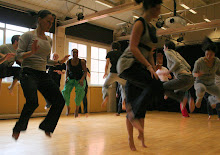1) Upon devising a piece of theatre, one must go through different stages of the devising process. During the creation of ‘Porto’; we have worked through the ‘R’ and ‘S’ stages of the ‘RSVP’ model. The ‘R’ stands for the ‘research’ phase; this is where the concept for ‘Porto’ was shared with the ensemble. We were shown several images; which we learnt were representations of what ‘Porto’ means; the transition between spaces. Also in the ‘R’ stage, we were given tasks to work in a starting point for the individual development of characters. As Dymphna Callery states of choreographer Lloyd Newson, who founded ‘DV8’, he wanted ‘to create rather than simply interpret, Work was devised […] through shared research’ (Callery; 2001: p.g.7).
From there, we began the physical creativity of ‘Porto’, it is here where the ‘scoring’, the ‘S’ stage, of the piece begins. ‘Borrowing [from] the musical term to indicate that the principle of creation is one of composition rather than linear plot construction’ (Callery; 2001: p.g.165). This is where the material gathered in the ‘R’ stage begins to take shape and is created through improvisation, being choreographed/directed, group devising and creative play sessions as ‘play will inevitably inform the style of work you produce’ (Callery; 2001: p.g. 163).
Overall, the transition to the ‘scoring’ of ‘Porto’ ran smoothly.
2) As ‘Porto’ is starting to become scored, there will inevitably be some form of narrative that will run through out the performance. However, because the work created through out ‘Porto’ has been devised in a non linear manner it is difficult for the ensemble to notice any clear sign of narrative through the piece. I do believe that narratives between individual characters have become apparent. Due to the very start of the ‘scoring’ phase during creative play sessions and group devised work ‘each [character] explored what they felt was important for them’ (Hodge; 2000: p.g.215).
It is this exploration of what each character needs, does not need, feels or does not feel towards themselves and other characters within the ensemble, i.e. ‘the physical dialogue’ (Murray & Keefe; 2007: p.g.120) that creates individual and personal narratives for each character in ‘Porto’.
It could be, however, that it is these ‘physical dialogues’ (Murray & Keefe; 2007: p.g.120) between characters, is the narrative of ‘Porto’. That an audience member may identify with a character on stage and follow their journey through out the performance of ‘Porto’ and the journey of the character becomes the narrative for the audience member. Or at a simpler level, the narrative for ‘Porto’ is the journey and development of the characters.
3) My character development from the ‘R’ to the ‘S’ phase of devising ‘Porto’ has been a massive one. My character has completely changed. As mentioned in my previous blog entry, my initial character was me and was incredibly difficult to develop both the physicality and the emotional sate of the character. So my character became a stereotypical ‘bitch’. This came from returning to the ‘R’ phase and making ‘discoveries […] individually. Such work is particularly useful for developing characters’ (Callery; 2001: p.g.173) while also having the emotional impulse to work with another performer who I related to, allowed the ‘improvisation […] to focus on the interactive process’ (Callery; 2001: p.g.173), thereby allowing my character to develop.
From working with my new character during the ‘S’ phase, it has allowed my character to grow and one again change emotionally. From a stereotypical ‘bitch’, my character has grown into an ‘evil’ character’; one that many members of the ensemble fear to be around. As Pina Bausch states ‘we all want to be loved and liked. You think that there’s a point and if you go beyond that, then there’s no telling where it will lead’ (Huxley & Witts; 1996: p.g.58). Which is true of my character, but working through the ‘S’ phase of ‘Porto’ it has allowed me to ‘develop [my] ability of physical expression’ (Zarrilli; 1995: p.g.163).
Bibliography
Callery, D. (2001): Through the Body, London. Routledge
Hodge, A. (2000) Twentieth Century Actor Training, London. Routledge.
Huxley, M & Witts, N. (1996) The Twentieth Century Performance Reader, London. Routledge
Murray, S & Keefe, J. (2007) Physical Theatres: A Critical Introduction, Oxon. Routledge
Zarrilli, P. (2002) Acting (Re)Considered: A Theoretical and Practical Guide, 2nd ed. Oxon. Routledge
Posted By: Edward Critchlow
skip to main |
skip to sidebar
Welcome to Porto2009.
This is the begining of our journey on the road of Porto2009. And the blog will give us the opportunity as a group to reflect on the work in which we have done within the sessions. We will keep you posted regarding the process we are making along the way.....
Enjoy.
Enjoy.



No comments:
Post a Comment